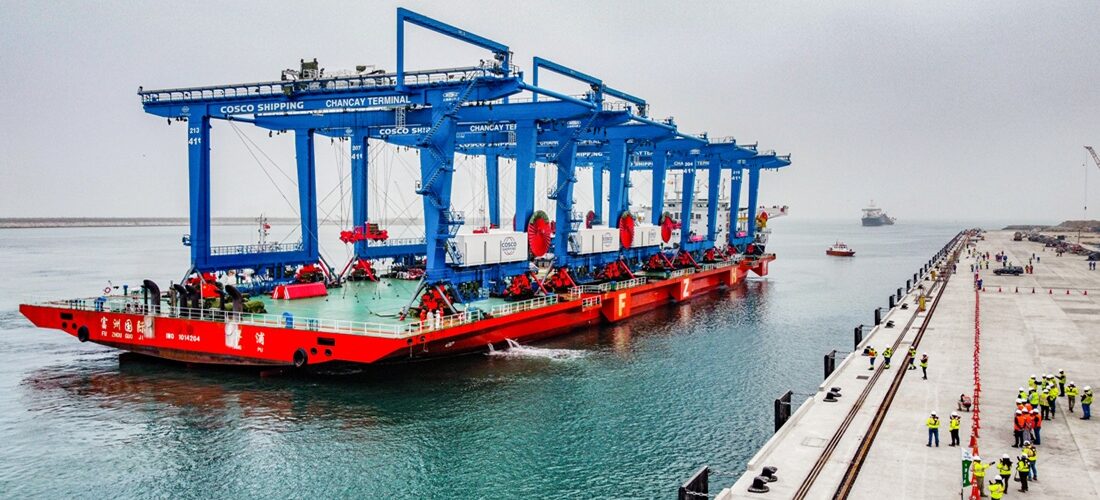
A Look at Peru’s Monumental Chancay Megaport, Set to Transform South American Trade
Oct, 31, 2024 Posted by Gabriel MalheirosWeek 202443
A new Peruvian port is set to become the largest on the South Pacific coast, potentially transforming trade across South America. The Chancay Megaport, developed by Cosco Shipping Ports Chancay Peru, promises to reshape regional logistics and trade flows.
China’s ambassador to Peru, Liang Yu, described the port as a potential “Shanghai of South America,” according to La República in June 2022. The port’s grand opening is expected this November, with Chinese President Xi Jinping attending during the APEC summit in Lima.
Located 80 km north of Lima, the project was first envisioned in 2007 by the late Peruvian naval officer Juan Ribaudo De La Torre, who originally owned the land where the port is being built, as noted by Lampadia.com.
The project is majority-owned by Cosco Shipping Ports Limited, a major Chinese maritime conglomerate and one of the world’s largest shipping operators, with a 60% stake. The remaining 40% belongs to Peru’s Inversiones Portuarias Chancay.
Chancay’s Operations and Technology:
With an investment of $1.3 billion, Chancay is equipped with cutting-edge technology and sprawling infrastructure visible only from above. Once operational, it will reduce transit times for goods shipped to Asia by almost half, poised to handle high volumes of global cargo.
A recent CNN visit highlighted the massive 90-meter gantry cranes that will transfer containers from ships to a large dockside yard. Nearly all operations will be autonomous and run 24/7.
The port’s layout has three main sections: an entry complex, a tunnel under the city, and the operational pier area. Built with global sustainability and productivity standards, Chancay’s infrastructure sets a new standard, said Carlos Tejada, Deputy General Manager of Cosco Shipping Ports Chancay Peru.
Chancay will operate continuously without shift changes, which Tejada noted as key to boosting productivity by 50%. “The world’s most efficient ports average around 30 containers per crane per hour; here, we aim for 50. Energy consumption is also reduced, which impacts freight costs and enables faster vessel turnaround,” he explained.
The port is fully electric, employing autonomous vehicles in its first phase, which consume 40% less energy than similar ports. Additionally, all export-bound cargo will be scanned with equipment supplied by U.S. Customs.
Chancay is designed to withstand an 8.5-magnitude earthquake and a subsequent tsunami, Tejada emphasized.
With a depth of 17.8 meters, Chancay will accommodate the world’s largest ships and cut transit times to Asia in half.
Currently, most Pacific coast cargo is transshipped through Manzanillo, Mexico, or Long Beach, California, resulting in a 40-day journey to Asia. Cosco aims to offer direct routes from Chancay to Shanghai, reducing travel time to 21-23 days, according to Tejada.
Cosco projects that this direct route will significantly impact cargo volumes at ports in Colima, Mexico, and California, as much of the South Pacific coast’s trade with Asia currently relies on these transshipment hubs.
Once completed, Chancay will allow countries like Ecuador, Colombia, and Chile to export goods directly to China via Peru, reshaping Pacific-Asia and Oceania trade routes.
The Chancay Megaport marks an important milestone in China’s influence in Peru and Latin America, prompting some U.S. officials to express concerns about China’s growing economic presence in the region.
Chancay is expected to begin commercial operations in early 2025, Tejada confirmed.
With information from Jimena De La Quintana.
Source: CNN Español
-
Ports and Terminals
Dec, 02, 2019
0
ANTAQ will hold public hearing on port area bidding in Aratu (BA)
-
Shipping
Sep, 18, 2024
0
Strong dry bulk market fuels 42% drop in ship recycling
-
Ports and Terminals
Jun, 25, 2024
0
PortosRio gains leadership in budget execution among public ports
-
Trade Regulations
Sep, 23, 2020
0
Measure approved to exempt EPZ companies from 80% gross revenue target

